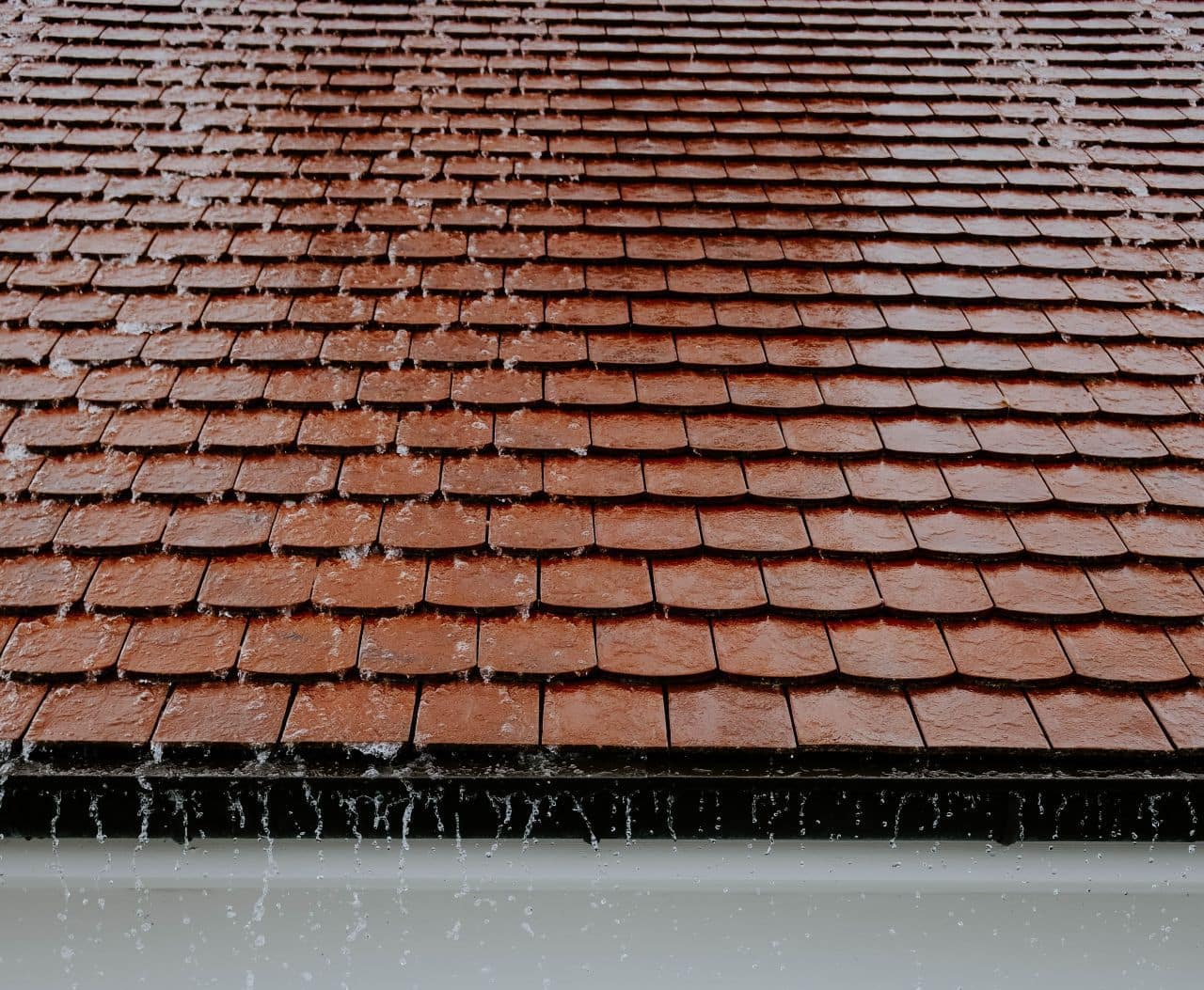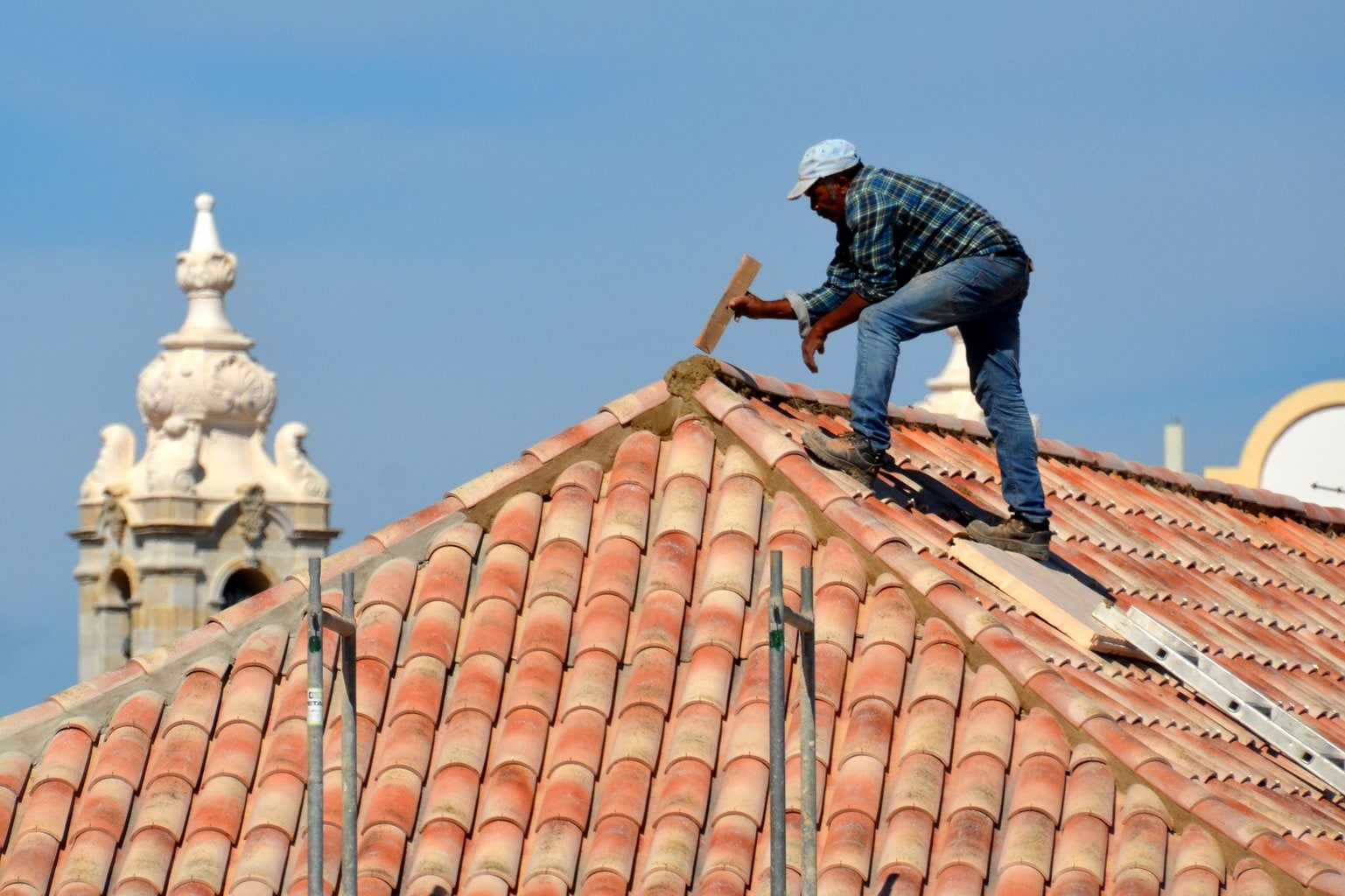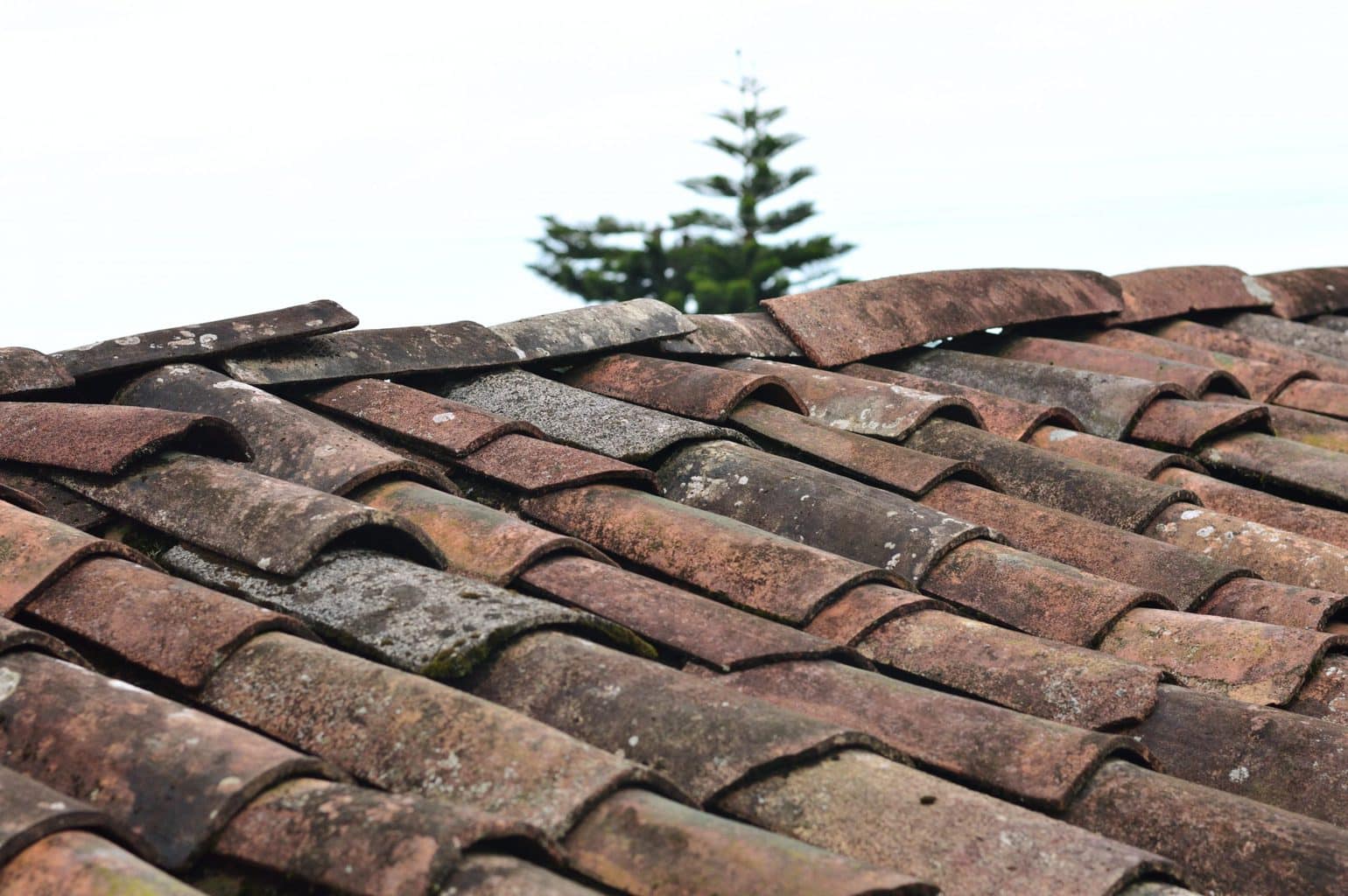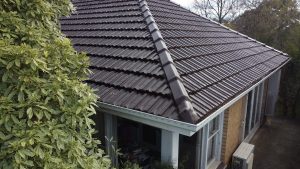If you find water dripping from a bulge or discolouration in your ceiling, it’s likely that water is pooling on the other side of that bulge or dark spot. Grab a bucket, trash can, or some other container and place it under the site of the drip or suspected leak. You may even want to consider propping up a board inside the container, so the drips hit the board and not the accumulated water. This will minimise the repetitive dripping sound.
Next, take an old screwdriver, locate the centre of the bulge where water is accumulating and puncture it right in the middle. Though it might seem strange to punch a hole in your ceiling to stop a leak, the new hole will allow the water to drain smoothly and relieve pressure on the rest of your ceiling. If water accumulates and pools, the entire ceiling could collapse.
If you are confident you know where the leak is coming from and can safely get to the source, cover the exterior surface with a large tarp. If you can’t reach it or feel unsafe doing so, it would be best to contact a roofing professional immediately.
Many credible roofing companies offer emergency tarping services. As you may already know, unfortunately, if your roof is actively leaking due to weather, a roofing professional can not repair the leak until that weather has stopped. The tarping service will act as a temporary fix to minimise the damage inside your home until your roofer can fix the problem.
An experienced roofing professional will inspect your roof both from the exterior of the roof itself and the inside of your home, typically through the attic. Inspecting the underside of the roof sheeting can show signs of water damage, however, it is not a foolproof method, so inspecting the roof for damage is needed as well. We have a wide range of Melbourne roof replacement services at Top Glaze.
Why Do Roofs Leak?

- Heavy storm: this is pointless to say, seeing how anyone will figure out it’s the storm that caused the problem. Nonetheless, try to remember if there was a storm recently. Even if there was a storm two months ago, it could still be the source of the problem. It takes time for the leak to appear.
- Old roof: It doesn’t matter what your roof is made of. Over time it will degrade. This leads to holes in your roof and higher chances of leaks. More so, an old roof and a big storm is a catastrophe waiting to happen. If this is your situation, fix the leak to prevent further damage to your home and think about replacing it as soon as possible.
- Bad instalment: If you have lived in your house for more than 2-3 years and haven’t had problems with a leaking roof, this doesn’t concern you. However, if you’ve just moved in or recently renovated your roof, there’s a chance that it isn’t installed properly. For this situation, I highly recommend hiring a professional.
- Shingles or tiles are damaged:There are a number of reasons why a shingle or a tile would be damaged. Try to remember if there was a heavy storm in your area recently. If one tile or shingle is damaged, chances say there will be a hole in your roof. Luckily, this is easily fixable from inside your house, and anyone handy can do it.
- Damaged leak preventers: By leak preventers, I mean objects installed around chimneys or roof windows to keep water from entering your house. If installed incorrectly, the preventers will not be efficient. Of course, time can also affect these objects, so keep that in mind too. Unfortunately, this problem can’t be fixed from inside your house.
- Chimney is damaged: Of course, not all houses have chimneys. This goes for those that do have one. If it’s poorly installed or old, the chimney’s base may be the cause of the leak. Sometimes storms can cause the issue, but it’s not that common.
That’s about it. Let’s see how to locate the leak. Also, sometimes a naughty neighbour can be the cause of the leak. I’m not suggesting anything, but if you have had problems with your neighbours in the past, it’s reasonable to assume that someone wanted revenge.
Ways to Stop a Roof Leak Temporarily
Dealing with a roof leak can be tricky. Leaks can cause havoc in no time at all, even while you’re waiting for your roof repair specialist to arrive. There are some handy quick steps that you can take to temporarily fix your leaking roof and avoid any potential damage. Let’s have a look at each of these steps.
First Things First
Make sure you don’t panic. Just take one thing at a time. It’s really important to help minimise any interior damage that the roof leak may cause. Be sure to get some buckets to help catch the water and then locate the leak.
You can do this by checking if the ceiling boards absorb moisture or by looking for drips coming from the ceiling. You want to ensure that water is not accumulating above the ceiling boards as this water’s weight could cause your ceiling to collapse.
If you can see a small dripping area, you may need to create a small hole to allow the water to drain out. Make sure you put a bucket underneath to catch the water. The next thing you need to do is to locate the source of the leak. Remember to always check in your attic for the leak if you have one.
Cover Your Roof Leak With Tarp
Tarps can be a very handy material to temporarily keep the water out. Once you have found the leak, if it’s in your attic, you will need to secure a tarp over the area by either tying it down or installing nailer boards such as 1×2’s to prevent it from flying off. Make sure that the ends of the tarp extend over the ridge of your roof to increase the tarps ability to retain water. If one layer isn’t enough, you may need to consider installing a second tarp a few inches below the first one.
If you don’t, Be aware – this is only a very temporary solution, and every caution should be taken when putting up the tarp.
Use Roofing Cement

A tube of plastic roofing cement is always handy to have around for emergencies such as a leaking roof. Plastic roofing cement is designed to seal holes in roofs, and it gets to work quickly. You’ll need to make sure that you have the correct tools to apply the roofing cement. Make sure you have a roofing trowel or putty knife in order to apply the cement. You also want to make sure that you apply enough cement to adequately cover the hole.
Find Roofing Tape
Another quick solution is to stick some roof tape onto the leak. Roofing tape is widely available and should be applied to the inside of your roofing material. Roofing tape can be quickly applied by just tearing off some pieces of tape and patching them over the leak. Again, this is a temporary fix, and you’ll need to keep an eye on its hold just in case you need to apply more tape.
Use Roof Mastic
If your roof leak is visible because of a missing tile or shingle, then an easy solution is to get a can of high-grade roofing mastic to apply over the leak. Mastic or Roofing Cement can be applied over the leak to temporarily stop the water from coming in. You’ll need to push the mastic into any holes or cracks that are present to ensure that it seals well. Also, make sure to spread it a couple of inches around the area to prevent any further leaks.
7 Signs You Need a Roof Restoration or Repair
As your home’s principal protection from the sun, hail and rain, your roof is created to endure the elements in order to stay strong. But over time, even the best roof will eventually need repair, replacement or restoration. But how do you know when it’s time to look at a new or restored roof? We’re here to help. Here are seven signs that you need a roof restoration, replacement or repair. Top Glaze has the best range of services if you’re looking for Melbourne roof repairs.
From inside
It’s often possible to spot signs of a deteriorating roof simply from looking inside your home. Some things to look out for include signs of light coming through the roof, trails that indicate leaking, or dark spots, which may indicate water damage. If you find just one sign that water is finding its way through your roof, there’s a good chance you just need a roof repair. However, if several areas are affected, you will need your roof restored or even replaced in all likelihood.
From outside
Depending on your home, you may need to get on a ladder and take a closer look at your roof from the outside. To be safe, avoid walking on a steep roof and take care when walking. Things to look out for include:
- Worn out or loose materials around the chimney, pipes, vents, and other areas where the roof has been sealed or penetrated.
- Signs of wear around the roof valleys
- Signs of mould, rot or moisture
- Curled or worn shingles
- Shingle granules around your gutters (indicating a need for shingle replacement)
- Any sign of damage or wear around gutters and downpipes
Sags

Any sign of sagging in your roof, either visible from the inside or outside, is a clear indication of roof damage. If sagging is visible, you may need to have your entire roof replaced. You must have the roof inspected professionally if any sign of sagging is visible.
Flashing
Typically, flashing in older homes was made of cement or tar. But both of these materials are prone to breaking down over time. Inspect your roof for signs of cracks, breaks or worn out areas. Consider replacing all your flashing material replaced with more modern metal flashing to avoid leaks as well as the need for premature roof replacement or restoration.
Age
Like anything, roofs age over time. A rule of thumb is that any roof should last between 20 and 25 years. If your roof is only 10-15 years old and needs repairs frequently, it’s a good idea to look at having it restored. This will ultimately be less expensive than having to frequently pay for repairs. If you’ve reached the 20-year mark, consider replacing your roof entirely.
Crumbling or cracked tiling
If you see any signs of cracked or broken tiles, they need to be replaced immediately. Tile roofing is very durable and rarely needs to be completed replaced, but if you overlook individual damaged tiles, water can seep in, and the timber holding up your roof will rot, creating a much more expensive replacement or restoration.
Corrosion
Corrosion is usually a sign that water is gathering around metal fittings and fasteners. If you see signs of corrosion around your gutters or anywhere else close to metal, it’s important to take a closer look. If you see paint flaking off around a corroded area, rotting timber, or other signs of damage, you need to replace the corroded fasteners and fittings before it becomes a much bigger job. Check out our roof guttering Melbourne services here.
We recommend inspecting your roof at least twice a year, and it’s ideal to have it professionally inspected every two years, as well as after major storms. It’s important to make sure the expert inspecting your roof shows you the signs of damage and explains exactly why you need a roof repair, replacement or restoration.
We also suggest you get quotes from several services in your area that are reputable and have been in operation for years. Any professional roofing contractor should be able to provide you with references from satisfied customers in order to ensure your money is well-spent.




